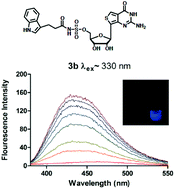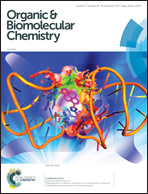Switch-on fluorescent/FRET probes to study human histidine triad nucleotide binding protein 1 (hHint1), a novel target for opioid tolerance and neuropathic pain†
Abstract
Histidine Triad Nucleotide Binding Protein 1 (Hint1) has emerged to be an important post-synaptic protein associated with a variety of central nervous system disorders such as pain, addiction, and schizophrenia. Recently, inhibition of histidine nucleotide binding protein 1 (Hint1) with a small nucleoside inhibitor has shown promise as a new therapeutic strategy for the treatment of neuropathic pain. Herein, we describe the first rationally designed small molecule switch-on probes with dual fluorescence and FRET properties to study Hint1. Two non-natural fluorescent nucleosides with a fluorescent lifetime of 20 and 25 ns were each coupled through a linker to the indole ring, i.e. probes 7 and 8. Both probes were found to be water soluble and quenched intramolecularly via photoinduced electron transfer (PET) resulting in minimal background fluorescence. Upon incubating with Hint1, compound 7 and 8 exhibited a 40- and 16-fold increase in the fluorescence intensity compared to the control. Compounds 7 and 8 bind Hint1 with a dissociation constant of 0.121 ± 0.02 and 2.2 ± 0.36 μM, respectively. We demonstrate that probe 8 exhibits a switch-on FRET property with an active site tryptophan residue (W123). We show the utility of probes in performing quantitative ligand displacement studies, as well as in selective detection of Hint1 in the cell lysates. These probes should be useful for studying the dynamics of the active site, as well as for the development of fluorescence lifetime based high throughput screening assay to identify novel inhibitors for Hint1 in future.



 Please wait while we load your content...
Please wait while we load your content...